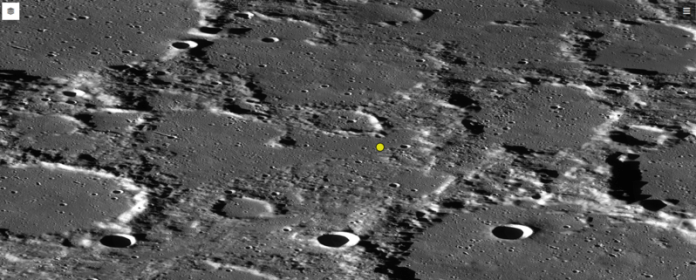The APXC instrument aboard the lunar rover of ISRO’s Chandrayaan-3 moon mission conducted in-situ spectroscopic study to ascertain abundance of elements in the soil around the landing site in south polar region of the Moon. This was the first in-situ study of elemental composition in lunar soil in south polar region (previous studies had analysed soil composition in equatorial to mid-latitude regions). Findings showed uniformity in composition lunar soil. Ferroan Anorthosite (FAN) rock, rich in plagioclase mineral was predominantly present. This a product of lunar magma ocean (LMO) crystallization. Abundance of magnesium-rich minerals was also detected suggesting contribution from the deeper layer of the Moon. Overall, this study supports Lunar Magma Ocean (LMO) hypothesis of evolution of the Moon.
ISRO’s Chandrayaan-3 moon mission demonstrated lunar soft-landing capability on 23 August 2023 when its lander descended on moon’s surface near south pole at the 69.37-degree South latitude and 32.35-degree East longitude (later named Shiv Shakti point).
The deployed rover explored the nearby area traversing about 103 meters for the next ten days and conducted in-situ experiments using the Alpha Particle X-ray Spectrometer (APXS) instrument aboard the rover.
The mission measured the composition of elements in the moon’s soil at the locations of stops of the rover by deploying the APXS instrument close to the surface for measurements and stowing it back while moving. X-ray Fluorescence Spectroscopy and Particle Induced X-ray Emission techniques were used to detect and quantify various major and minor elements present in lunar soil, such as Si, Mg, Al, Fe, Ca, as well as Mn, Cr, Ti, Ni, K, Na, and, S etc. By irradiating the lunar surface with its Cm-244 sources, APXS recorded characteristic X-ray lines of all major and minor elements. The APXS made 23 observations along the path of rover and obtained an X-ray spectrum at each location.
This is the first in situ measurements of compositions of elements in the lunar soil in the southern high-latitude regions of the Moon. Previous studies of measurements of elements in the lunar soil were made using samples collected from equatorial to mid-latitude regions by the Apollo, Luna and Chang’e 5 missions, lunar meteorites of unknown location of origin and the in-situ measurements from the mid-latitude regions by the Chang’e 3 and Chang’e 4 missions.
The analysis of APXS data from the 23 measurements in the each location near the landing site has revealed that the elemental composition is uniform across the area explored by the rover. The soil is a mixture of two types of rocks. Ferroan Anorthosite (FAN) rock, rich in plagioclase mineral is a product of the lunar magma ocean (LMO) crystallization. The APXS instrument also detected higher abundance of magnesium-rich minerals.
Knowledge of composition of elements in the lunar surface is important for understanding formation and evolution of the Moon. According to the Lunar Magma Ocean (LMO) hypothesis, the Moon was entirely an ocean of Magma in the beginning. The heavier minerals sank and formed the inner layers as the magma cooled. Simultaneously, the lighter minerals floated and formed the outer crust of the Moon.
The dominant presence of Ferroan Anorthosite (FAN) in the lunar soil in the rover landing site region, which is the main finding of this study supports Lunar Magma Ocean (LMO) hypothesis. Presence of magnesium rich minerals suggests mixing with minerals with from inner layer.
***
References:
- Vadawale, S.V., Mithun, N.P.S., Shanmugam, M. et al. Chandrayaan-3 APXS elemental abundance measurements at lunar high latitude. Nature (2024). https://doi.org/10.1038/s41586-024-07870-7
- ISRO Media release. PRL-built APXS on Pragyan Rover of Chandrayaan-3 made the First Elemental Abundance Measurements of Lunar Soil in the South Polar Region of the Moon. Posted 21 August 2024. Available at https://www.isro.gov.in/media_isro/pdf/APXS_CH3.pdf
***
Related articles:
Lunar Race: India’s Chandrayaan 3 achieves Soft-landing capability (23 August 2023)
ISRO Launches Chandrayaan-3 Moon Mission (14 July 2023)
JAXA (Japan Aerospace Exploration Agency) achieves Lunar soft-landing capability (20 January 2024)
‘Gateway’ Lunar Space Station of ‘Artemis Mission’: UAE to provide an Airlock (8 January 2024)
Lunar Race 2.0: What drive renewed interests in moon missions? (27 August 2023)
Mass Extinctions in the history of Life: Significance of NASA’s Artemis Moon and Planetary... (23 August 2022)
Artemis Moon Mission: Towards Deep Space Human Habitation (11 August 2022)
The Moon’s Atmosphere: Ionosphere has high Plasma Density (9 August 2022)
PHILIP: Laser-Powered Rover to Explore Super-Cold Lunar Craters for Water (18 May 2020)
***




































